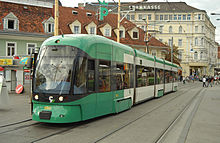Graz trams

A Cityrunner tram in Jakominiplatz, 2007.
|
|||||||||||||
| Operation | |||||||||||||
|---|---|---|---|---|---|---|---|---|---|---|---|---|---|
| Locale | Graz, Styria, Austria | ||||||||||||
| Status | Operational | ||||||||||||
| Lines | 6 | ||||||||||||
| Operator(s) | Holding Graz (since 2007) | ||||||||||||
| Infrastructure | |||||||||||||
| Track gauge |
1,435 mm (4 ft 8 1⁄2 in) standard gauge |
||||||||||||
| Electrification | 600 V DC | ||||||||||||
| Stock | 86 | ||||||||||||
| Statistics | |||||||||||||
| Route length | 67.2 km (41.8 mi) | ||||||||||||
| Passengers (2012) | 53.56 million | ||||||||||||
|
|||||||||||||
|
|||||||||||||
|
|||||||||||||
| Website | Holding Graz Linien (in German) | ||||||||||||
The Graz tramway network is a network of tramways forming an important part of the public transport system in Graz, which is both the capital city of the federal state of Styria, Austria, and the second largest city in Austria.
In operation since 1878, the network presently has six daytime lines, and five evening and Sunday lines. As of 2012[update], the Graz tram network ran on an almost 60 kilometres (37 mi) of route, and served 53.56 million passengers. It is operated by the Graz Linien division of Holding Graz, the city owned utility company who also operate the city's bus network and the Schlossbergbahn funicular railway. The trams form part of the styrian integrated fare system which covers all modes of public transport in Graz and Styria.
The Tramway Museum Graz, at the terminus of line 1 in Mariatrost, holds many exhibits relating to the system.
The first trams to run in Graz were horse trams in private ownership, with service commencing in 1878. The lines were electrified from 1899. In 1939, the tram network was acquired by the city.
In 1941, the narrow gauge electric railway that had linked Graz with the suburb of Mariatrost since 1898, was converted to standard gauge and became part of the tram network. The resulting long outer section of tram route 1 still retains many light railway features, with its off-street routing and long stretches of single track.
The Graz tram network reached a peak in 1950. Growing car ownership, and the growth of residential areas in outer reaches of the city not served by the trams, lead to a fall in tram usage and eventually, after 1950, the closure of several tram routes. The city introduced trolleybuses in 1941 to serve the outer areas of the city, but these were replaced by motor buses by 1967.
...
Wikipedia

